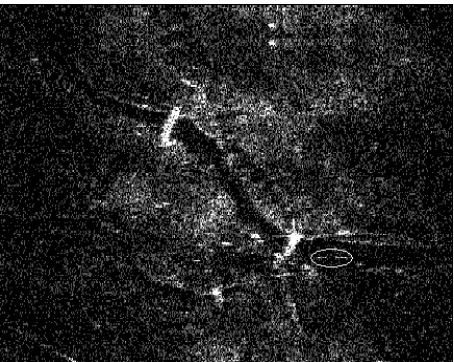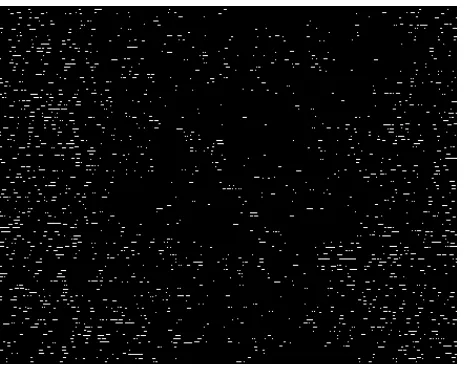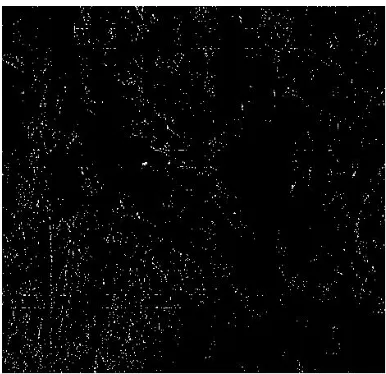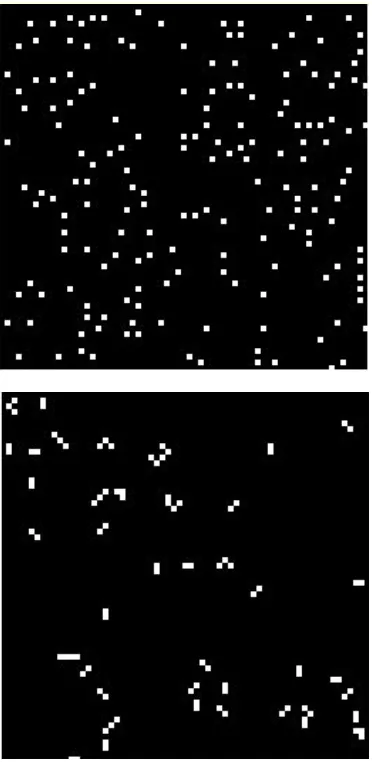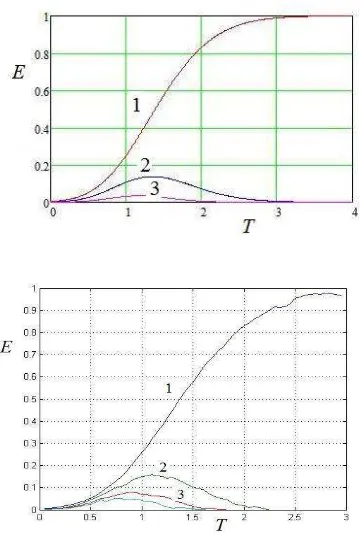EXTRACTION OF EXTENDED SMALL-SCALE OBJECTS IN DIGITAL IMAGES
V. Yu. Volkov a, b
a
Dept. of Radioengineering, The Bonch-Bruevich State Telecommunications University, Saint-Petersburg, Russia – [email protected]
b
Dept. of Radioengineering, State University of Aerospace Instrumentation, Saint-Petersburg, Russia
Commission III, WG III/3
KEY WORDS: Filtering, Segmentation, Extraction, Automatic threshold control
ABSTRACT:
Detection and localization problem of extended small-scale objects with different shapes appears in radio observation systems which use SAR, infra-red, lidar and television camera. Intensive non-stationary background is the main difficulty for processing. Other challenge is low quality of images, blobs, blurred boundaries; in addition SAR images suffer from a serious intrinsic speckle noise. Statistics of background is not normal, it has evident skewness and heavy tails in probability density, so it is hard to identify it. The problem of extraction small-scale objects is solved here on the basis of directional filtering, adaptive thresholding and morthological analysis. New kind of masks is used which are open-ended at one side so it is possible to extract ends of line segments with unknown length. An advanced method of dynamical adaptive threshold setting is investigated which is based on isolated fragments extraction after thresholding. Hierarchy of isolated fragments on binary image is proposed for the analysis of segmentation results. It includes small-scale objects with different shape, size and orientation. The method uses extraction of isolated fragments in binary image and counting points in these fragments. Number of points in extracted fragments is normalized to the total number of points for given threshold and is used as effectiveness of extraction for these fragments. New method for adaptive threshold setting and control maximises effectiveness of extraction. It has optimality properties for objects extraction in normal noise field and shows effective results for real SAR images.
1. INTRODUCTION
The task of detection and localization of small extended objects in noisy images occur in the electronic surveillance systems using radars with SAR, infrared and laser systems, as well as television cameras (Gao, 2010; Gonzalez, Woods, Eddins, 2004). This task is relevant, because these facilities typically have an artificial origin and are of Prime interest.
Upon detection, extraction and localization of such objects had substantial difficulties in building effective algorithms and structures processing, as in taken images there is intense and non-stationary background, also contains elements that are structurally similar to the signals, the signal/background is usually small, and the registered digital image has a low quality, small number of quantization levels, patency character and fuzzy borders of natural and artificial structures (rivers, roads, bridges, buildings).
Statistics background is very different from a Gaussian, the distribution is clearly asymmetric, and the tails of the distributions like lognormal density normal or mixed (contaminated-normal), and when small volumes of samples are identified with difficulty.Such a character background virtually eliminates the use of the known methods of thresholding, since improper formation thresholds can cause loss of useful objects at a very early stage of processing. You cannot use traditional methods of detecting contours in images in order to highlight natural features (rivers, roads, borders, windbreaks, etc.), which are based on the formation of the spatial derivatives (gradients and Laplacians), because the result will be a significant growth impulse noise without visible effect for selection of quality circuit.
The basic principles that allow solving this difficult problem, are the location-based filtering, adaptive thresholding and selection of useful sites on the connectivity of neighboring pixels given the length of the useful structures (Gonzalez, Woods., Eddins, 2004).
2. PROBLEM STATEMENT AND METHOD OF OBJECT DETECTION
Suppose there is a classification problem, so that objects have to be extracted belong to certain classes. But these classes have no precise description and this is the object of investigation. One of the main features for object segmentation is its extension. Useful objects are usually extensive, after binarization they consist of connected points, and look like lines or blobs.
Solving of segmentation problem includes thresholding and selection of objects with different extensions. Threshold processing gives binary image and the following segmentation is realized with special method of extraction. Dynamical threshold setting is the problem which should be solved with taking into account results of segmentation.
The aim of this paper is to develop method for segmentation and extraction of extensive objects with unknown sizes and orientations. Method proposed includes extraction of isolated fragments after binarization of pre-filtered image. Method also includes logical filtering with corresponding masks and allows extracting isolated fragments with different sizes and orientations.
Different isolated fragments differ in their sizes and orientation. Hierarchy of isolated fragments is proposed which relates to
their extensions and orientations and characterizing mask of fragment is inserted.
Setting of threshold is the main problem for qualitative segmentation. Low threshold level gives much noise, and the following processing becomes inefficient, too high level results in destroying of useful objects which may be split up to small fragments. The best threshold should be set after analysis of segmented fragments with the use of some quality indicator for extraction and segmentation. It is desirable to get some attributes which characterize the quality of segmentation. The simplest attribute is proposed here as the number of points at each step of extraction. It should be normalized to the initial points in binary image and represents the effectiveness of extraction at corresponding step.
It is worth noting that threshold setting is dependent on pre-filtering processing. The general idea of threshold setting and control via results of segmentation is admissible for different pre-filtering algorithms. It also may be used for local thresholds in sliding windows.
Consider there is an image in digital form, containing useful objects, which have a relatively small length in relation to the size of the entire image and an arbitrary orientation. Shape of objects of interest can be linear or speckle, and their length is specified by specifying a maximum size or length of the object in pixels, and set the minimum and maximum bounds on the length of objects. The problem feature is that the emergences of small-scale objects of interest practically no effect on the integral characteristics of the image.
There are two examples of extended small-scaled objects in SAR images which are shown in Fig. 1 and Fig. 2. These objects are artificiallyhighlighted with a white oval. First image contains two oriented linear objects and the second image contains two blob-like objects inside corresponding white ovals. The general structure of digital image processing includes a pre-filter, binary quantization (threshold processing), and subsequent morphological processing (Fig. 3). The input image after registration is submitted in digital form (two-dimensional array on a rectangular grid of points).
Figure 1. Small-scale oriented objects to be extracted
The problem of automatic setting of the threshold in autonomous information and control systems is very important for segmentation (Akcay, Aksoy, 2007, Sezgin, Sankur., 2004, Weszka, Rosenfeld, 1978).
Figure 2. Small-scale blob-like objects to be extracted
Figure 3. Image processing structure for objects extraction
Well-known installation methods of global and local thresholds typically use histograms or local properties of the pixels in the image (Gonzalez, Woods., Eddins, 2004, , Sezgin, Sankur., 2004). In our case, the threshold processing should depend on the results of binarization (Volkov, 2009a, 2009b).
The purpose of this paper is to study adaptive method threshold segmentation for the detection and selection of objects based on structural decomposition of a binary image into elementary, isolated objects, analysis of the impact of the threshold on the results of the decomposition, and algorithm development for installation and changes the threshold in accordance with the results of the decomposition.
3. PRELIMINARY FILTERING
Pre-filtering aims to improve the image and highlight the differences and boundaries. It is assumed that the useful objects always have a higher intensity relative to the background, otherwise it is necessary to invert the image. In this case we applied the differentiating filters (Laplacian type), which permit to use a global threshold for binary quantization exceeding the intensity threshold quantization.
When filtering oriented linear objects we used space-oriented mask filter of the following form (Fig. 4), which would have effectively allocate endpoints of the segments of unknown length. In this particular case the coefficients are
a
=
1
,1
− = b .
These masks should be used for searching fragments with different orientations for extraction all small-scale extended objects in the image.
Figure 4. Space-oriented filter masks
For blob-like small-scaled objects we used non-oriented filter mask which is presented in Fig. 5.
Figure 5. Non-oriented filter mask
Along with averaging in differentiating filters used other operators such as the sample median and selection the maximum value (in cells with coefficients b).
The results of preliminary filtering are shown in Fig. 6 and Fig.7 below.
Figure 6. The output of pre-filtering of image in Fig. 1
Figure 7. The output of pre-filtering of image in Fig. 2
4. THRESHOLD PROCESSING
This stage is very important. Incorrect threshold often results in irreversible losses of information. Suppose we are interested in objects with high intensity, and processing results in high level for pixels if threshold level is exceeded, and zero level otherwise.
Figure 8. Binary image after low threshold level
Fig. 8 - Fig.10 illustrate changes of binary images upon threshold variations from low to high levels for image shown in Fig. 7. As it may be easily observed from Fig. 8, low threshold (two pictures on top) is not appropriate because of segmentation problems: useful and noisy objects do not differ in extensions. As far as threshold level rises, differences between extensions of objects start to appear, but at very high levels (bottom pictures) we can see destroying of useful extensive objects. The best threshold level gives maximal differences in extensions between useful and noise objects.
Figure 9. Binary image after intermediate threshold level
Figure 10. Binary image after high threshold level
We can also see that for high thresholds bottom pictures has weak dependence on type of pre-filtering processing.
The main idea is to set threshold level according to segmentation results. For this purpose hierarchy of isolated fragments is proposed, and effectiveness of extraction is inserted as indicator of segmentation degree. It may be used for threshold setting and control.
5. HIERARCHY OF ISOLATED FRAGMENTS IN BINARY IMAGE
Our aim is to find out attributes of image which characterize extension properties of objects and allow us to control threshold level for qualitative segmentation. Suppose we have binary image after threshold processing. The concept of
characterizing mask for isolated fragments is introduced for analysis of segmentation results. It relates to definition of continuity and adjacency of pixels, here usual definitions are used (Gonzalez, Woods., Eddins, 2004, Volkov, 2009a, Volkov 2009b).
Fragments are isolated if they have no mutual pixels. Suppose isolated fragment consists of several adjacent pixels on the binary image.
Figure 11. Gaussian noise field (top picture) and the result of binarization (bottom picture) with threshold level equals to 1.5
Extension properties of isolated fragment may be characterized by size of minimal rectangular mask which entirely covers this fragment. Objects may include several isolated fragments. Extensive objects usually contain extensive fragments.
Fig. 11 in the bottom contains results of threshold binarization for Gaussian noise field with zero mean and standard deviation equals to unity (top picture) with threshold level equals to 1.5. Top picture in Fig.12 represents isolated points. After deleting isolated points there are lots of connected fragments with different sizes and shapes (bottom picture in Fig. 12).
It is possible to represent hierarchy of small isolated fragments which is shown in Fig. 13 up to characterizing mask 3x3. Isolated point has characterizing mask 1x1, it is shown at high left corner of figure. Isolated pairs may have characterizing masks 1x2, 2x1 or 2x2 corresponding to their orientations. Triple of points may form horizontal line (at high right corner of figure), vertical line (at low left corner), or diagonal lines (slash and inverted slash). Other fragments with three points may have different characterizing masks. Triple of points may also look like “corner”, and have characterizing mask 2x2. Extensive fragment with horizontal orientation has characterizing mask 2x3 if it is more in sizes than 2x2 but entirely covers by mask 2x3. Similar fragment with vertical “Gate” or “scoop” with three points has 2x3 or 3x2 masks.
Figure 12. Isolated points extracted (top picture) and remaining small-scale objects (bottom picture) after thresholding of Gaussian noise field
Four points give large variety of isolated fragments. Only square 2x2 is shown on Fig. 13. Square masks do not consider fragment orientations.
Hierarchy of fragments is their ordering and may be obtained by the choice of characterizing masks to be considered. Masks 2x3, 3x5, 3x7, 5x7 and other similar masks characterize horizontal fragments; masks 3x2, 5x3, 7x3, 7x5 describe vertical fragments.
The choice of set of characterizing mask allows us to obtain different attributes for describing fragments with different extensions and orientations.
The simplest hierarchy uses only square characterizing masks. Then we have 1x1, 2x2, 3x3, 5x5, 7x7 and so on, as characterizing masks of extensive fragments with increasing extensions. This hierarchy does not take into account orientations of fragments.
6. THRESHOLD SETTING AND CONTROL BY THE USE OF CONNECTED FRAGMENTS IN NOISE IMAGE
It is easy to verify that the number of extracted small-scale objects of the given type in binary image is small at both very low and high thresholds. Thus, with some intermediate value of the threshold number of such objects is maximal.
Figure 13. Hierarchy of small isolated fragments
However, along with the decrease in the number of the objects by increasing the threshold also decreases the total number of points in which intensities exceed the threshold.
Let after binary quantization with a predetermined threshold value
T
the image contains onlyN
(T
) pixels exceeding the threshold.At each step of extraction we use corresponding characterizing masks 1x1, 2x2 and so on. Extracted fragments are deleted from the image. Then at each step of the extraction binary image loses
N
1(T
),N
2(T
)...etc. points. Since all these numbers depend on the quantization threshold, it is necessary to perform the normalization, and to consider the relative valuesThese values can be considered as the estimates of effectiveness of extraction of fragments at the appropriate step with given quantization threshold. For homogeneous Gaussian noise field we can calculate probability that intensity in each pixel exceeds the threshold
where Φ(
T
) is a cumulative distribution function. Probability to occur an isolated point will be)]
and so on were calculated and represented on the top of Fig. 14. Numbers of lines correspond to characterizing masks 1x1, 2x2, 3x3, etc.Extraction efficiency for isolated points (line 1), fragments with characterizing mask 2x2 (line 2), and mask 3x3 (line 3). Lines for connected fragments have evident maxima at the threshold value 1.3. This is the best threshold for extracting small connected fragments from Gaussian noise field. These results are confirmed by simulation curves represented on the bottom of Fig. 14.
Figure 14. Extraction efficiency for isolated points (line 1), fragments with characterizing mask 2x2 (line 2), and mask 3x3
(line 3)
7. ADAPTIVE THRESHOLDING STRUCTURE
Processing structure containing adaptive threshold setting and control is shown in Fig. 15. Filter F produces pre-filtering, filter E realizes morphological operation for extraction isolated fragments with given characterizing masks. Binary quantizer obtains binary image with zero output level if input intensity is below a threshold and maximum level if input intensity exceeds a threshold. The threshold value should be varying and statistics are obtained which result in extraction efficiency.
Maximum selector obtains the threshold value which maximizes extraction efficiency for prescribed characterizing mask, length selector extracts small-scale objects with prescribed lengths.
8. EXTRACTION OF SMALL-SCALE OBJECTS FROM REAL SAR IMAGES
The results of the extraction and allocation of small-scale objects on real radar images presented in Fig. 16 and Fig 17 for the two images from Fig. 1 and Fig. 2 accordingly.
Top pictures represent outputs of binary quantizers which threshold were set for maximum extraction efficiency for small connected fragments. Objects of interest are highlighted by the ovals. Dependency plots of extraction efficiency upon threshold values are presented in the middle row of pictures.
Numbers 1, 2 and 3 correspond to connectivity of pixels in fragments. Pictures on the bottom show objects of interest extracted by the use of length selection.
9. CONCLUSIONS
New method of extraction and allocation small-scale objects is described which is based on pre-filtering, adaptive thresholding and morphological selection. It allows extracting small-scale objects with different extension and orientation.
Figure 15. Processing structure with adaptive threshold setting and control
Hierarchy of isolated fragments is proposed for analysis of connected fragments. Analysis of small connected fragments is useful for obtaining indicators for threshold setting and control. Extraction efficiency is introduced as the relative number of points in fragments with respect to all points exceeding threshold. The best threshold level should give maximal extraction efficiency for a given size of characterizing mask. Adaptive method for threshold setting and control has optimal property which was checked by modeling Gaussian field with extensive object region. Thresholds obtained are settled near the value of optimal maximal likelihood threshold for detection of shift on Gaussian field.
REFERENCES
Akcay H., Aksoy S., 2007. Morphological segmentation of urban structures. Urban Remote Sensing Joint Event, 11-13 April, Paris, pp. 1-6.
Gao G., 2010. Statistical modeling of SAR images: A Survey.
Sensors, pp. 775-795.
Gonzalez R.C., Woods R.E., Eddins S.L., 2004. Digital Image Processing using MATLAB. Englewood Cliffs, NJ: Prentice-Hall.
Sezgin M., Sankur B., 2004. Survey over image thresholding techniques and quantitative performance evaluation. Journal of Electronic Imaging, 13(1), pp. 146–165.
Volkov V., 2009a. Segmentation and extraction of extensive objects on digital Images. In: Proceedings of the 2009 International Conference on Image Processing, Computer Vision and Pattern Recognition. IPCV2009, II. Las Vegas, Nevada, USA, CSREA Press, pp. 656-662.
Volkov V., 2009b. Thresholding for segmentation and extraction of extensive objects on digital images. In:
Proceedings 32 Annual German Conference on Artificial Intelligence. KI 2009. Paderborn, Germany, Springer, pp. 623-630; Lecture Notes in Computer Science (including subseries Lecture Notes in Artificial Intelligence and Lecture Notes in Bioinformatics) 5803 LNAI , pp. 623. http://www.springer.com/computer/ai/book/978-3-642-04616-2
Weszka J., Rosenfeld A., 1978. Threshold evaluation techniques. IEEE Trans., SMC-8, pp. 622-629.
Figure 16. Extraction of small-scale objects from the image in Fig. 1
Figure 17. Extraction of small-scale objects from the image in Fig. 2
